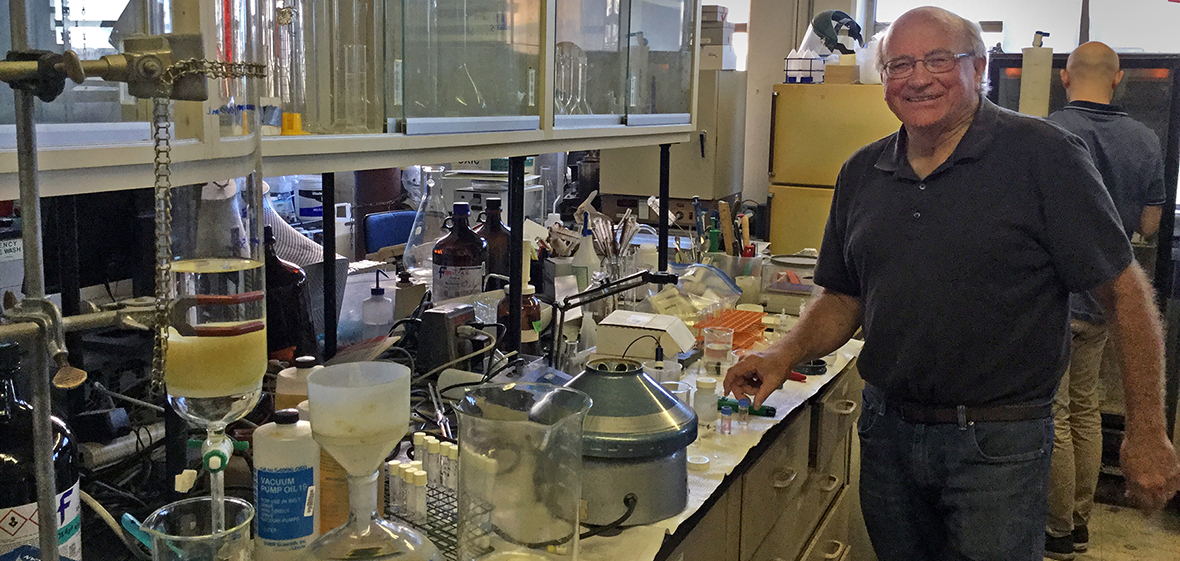Glenn Miller smiles and apologizes for the "messy lab" as I walk into his busy laboratory on the third floor of the Applied Research Facility.
The lab is roomy, but filled to capacity with equipment, supplies and several beakers and containers with liquid bubbling away at controlled temperatures and times. Miller is mixing and measuring some methane laced water for one of his several projects, this one related to hydraulic fracking. Graduate students move quickly around the room - not a messy space, just an active workplace.
He describes his scientific focus as "an eclectic group of projects, perhaps disorganized and random, things I thought would be fun." He came to the University of Nevada, Reno for a temporary position in 1978 to do laboratory analysis looking for contaminants in the environment. He never guessed he would be here for 40 years. His retirement officially began on June 29.
In the late 1970s, a plant biofuel project using roadside weeds was initiated at the University. Miller, a professor in the College of Agriculture, Biotechnology, and Natural Resources Molecular Biosciences Graduate Program, had just begun his teaching position and became involved in the project, a project he is still involved with to this day.
"I worked with a guy named Daryl Lemaire, who was a graduate of the University in the late 50s at the time, I think he's 90 now," Miller said. "But, he had a project from the Department of Energy to look at various plants in Nevada that might have biofuel potential. And he looked at a bunch of different things. He looked at extractable fuels, and the plant that he thought had by far the highest potential was Grindelia squarrosa, called gumweed."
Gumweed grows along roadsides and produces flowers every other year. One of the reasons it grows well along roadsides is the hard, asphalt surface it grows near. Water runs off the asphalt and seeps into the fairly permeable material right next to the asphalt. With all of the water reservoir underneath the asphalt, the Grindelia squarrosa is able to send its roots deep into the ground, picking up that water and therefore, growing effectively along roadsides, especially in more arid landscapes like Nevada.
"So, he (Lemaire) noticed it was growing and extracted it, he thought it had a good extractable concentration," Miller said. "We didn't see quite as much as he did, and we've looked at a lot of it. So, we're looking at about a 12.5 to 14 percent extractable hydrocarbons, which is actually pretty good, that's on a whole plant basis."
"And he did his report and we grew some in my garden at home, and about ten years ago I started growing a little bit in the field to see what would happen," Miller said. "We had similar very positive results, that we could get it to germinate, kind of, and ultimately we applied for some grant money to look at arid lands, biofuels, and bio-product - which is the title of this most recent research project on gumweed.
The team finished the research at the end of March. Miller just finished his final report on the project.
Biofuel extracted from roadside gumweed
"Most of our work has been on gumweed, with three other people: David Shintani in the biochemistry program, who has done quite a bit of work on rabbit brush, and then Hongfei Lin who was in chemical engineering, and Chuck Cornella, also in chemical engineering. They looked at other aspects of gumweed as fuel. And so the whole project was designed to look at these questions: ‘Are there products we can pull out of this? Are there ways we can convert this material to fuel?'"
The extractable substance of the gumweed plant itself is a dark colored material, and contains grindelic acid which can be converted to a biofuel. One of the main goals of this project was to make this conversion efficient and cost effective.
"We're primarily looking at a diesel fuel, so we've looked at conversion of this material into
various fuel properties," Miller said. "We've found that if you add a little bit of aluminum oxide, a very inexpensive catalyst, you can distill material that has characteristics very similar to diesel or jet fuel.
"The idea is to produce a fuel that can compete with diesel, and we soon realized that's probably not
going to happen until the price of fuel increases substantially. But on the other hand, if there's a requirement for renewable fuels that are carbon based, then we have some advantage in that this material can be converted fairly easy into a pretty good fuel, and that's one of the things we've done."
Miller said that looking at the production of this type of fuel has been their main focal point.
"A lot of what we did though is just looking at production of this fuel," he said. "The idea is that this plant requires very little water, it can be grown on land in Nevada that will not support corn or soybeans or grains. Therefore, it can be grown on land in Nevada that wouldn't have much use for intensive agricultural production."
While Miller said that the gumweed biofuel is not able to compete with hydraulically fractured fuel at the moment, it has potential as a non-competitive biofuel for environmental and economic sustainability.
He is hopeful about gumweed's potential.
"There's more work that needs to be done on it, we've gotten a fair amount of interest from a variety of people, but it will require some additional work to get people convinced that this has a
long-term viability.
"No one's jumping on the bandwagon, yet, to continue my part of the research, but it's nearly a pilot project with new processes and new infrastructure needed to talk farmers into growing this. The process works, it grows well in Nevada. It's just a price issue at this point."
While gumweed has been a passion his entire career in the Department of Natural Resources and Environmental Sciences, Miller's eclectic wanderings into other research areas brought him into several impactful projects, some that continue today: clean-up of the Leviathan Mine, dioxin environmental chemistry, gasoline contamination at Lake Tahoe with MTBE, road runoff into Lake Tahoe - depositing phosphorous into the lake, and closure of precious metals heaps.
Miller's work included precious metals mining in Nevada. He collaborated with the mining industry and the Department of Environmental Protection intermittently, bringing his skills as a chemist to help the industry and Nevada become "the best regulated state for precious metals."
"I'm really impressed with the State's DEP, they've come a long way and are doing very good things to protect the environment," he said. "Maybe the best thing is instituting a bonding process so when mines are closed there is a mechanism - and funding - to close the mines safely. I was a critic early on of the NDEP, but they are very good now."
Taking the knowledge he has of Nevada's mining industry, he has travelled to Peru, Mongolia and Malaysia to consult with the communities affected by mining in those areas, helping to define risk factors for their operations and put in place regulations to protect the environment.
"I tell the world to adopt our methods," he said.
Another mining area of interest to Miller is pit lakes, pit mines that are no longer used and fill up with water. Scientists study the geochemistry of precious metals mining pit lakes and can check the ecological toxicology of the lake and hopefully be able to manage the water quality over the long term. The long-term impact of these pit lakes on the environment is unknown, and they are investigating methods to predict the eventual water quality in these lakes.
At least one of the pit lakes actually has beneficial aspects, the Sleeper Mine pit lake. When visited recently, Miller noted that the water quality had stabilized and the pit lake contained fish, and hundreds of birds were present.
"We could convert pit lakes to recreational resources, there is more total water in Nevada in pit lakes than all of the other human-made reservoirs combined that are completely within the borders of Nevada," Miller said. "The chemistry problem on pit lakes has partially been solved with neutralization of the water, but they can have 100 to 200 foot high walls, so access is a problem, but once you are down on the water it's like you are in the middle of remote lake."
Gasoline in Lake Tahoe
In 1997 at Lake Tahoe Miller researched watercraft emissions - the amount of unburned fuel that gets into the water from operating small 2-cycle carbureted outboard engines. The carbureted engines dumped up to 30 percent of the gasoline directly into the lake through the exhaust.
With the help of the Tahoe Regional Planning Agency, and great cooperation from concessionaires, the engines were outlawed, and then replaced by fuel injected outboard engines. The new engines reduced emissions by up to 95 percent.
"They all said it makes sense to outlaw the outboard engines," he said. "The science made it so clear that this should be done."
Methane, Fracking and Drinking Water
The science around hydraulic fracking has also been on Miller's cornucopic list of projects.
"People are concerned that fracking brings up poor quality (salty) water and can destroy a drinking water aquifer," he said. "This does not commonly happen, but released methane does move as a gas into a drinking water source. While methane is not particularly toxic, certain types of bacteria can use it as a carbon source, resulting in production of hydrogen sulfide that renders the water unpalatable - you absolutely can't drink it."
He will be publishing a scientific paper on some of the research on this how methane effects on water can make it undrinkable.
In addition to projects related to contamination from current precious metals mining sites, Miller studies historic mines that are releasing acidic water. Working with a team of scientists, he helped develop an anaerobic bioreactor that uses sulfate-reducing bacteria to raise the pH of wastewater and also to remove metals and sulfate from effluent streams.
The new equipment and process was used at the Leviathan Mine in Alpine County, Markleeville, California. It is an EPA Superfund site. Miller worked with the current responsible company and the Lahontan Water Quality Control Board to find ways to clean up the water from the heavy metals left over from the mining process at the site upstream from Cason City.
Over the years, his team - working with the gasoline company ARCO - used trial and error to design and develop an effective bioreactor process used in the clean-up efforts. The bioreactors initially had a short lifetime, due to plugging.
"There was so much of those metals in the water that when they precipitated out in the process, it plugged up the reactors," he said. "We solved the problems with the reactors, and they are still operating and treating water all of the year, and have been operating well over 10 years."
Teaching and writing papers
Miller doesn't just love chemistry, field work and research. He loves teaching. Throughout his career he has had about 30 to 40 students a year, has had 20 doctoral students and 40 masters students.
"I'll probably be around here for at least six months to finish some projects," he said. He has five graduate students working on several projects, but he's also said he could be around as an emeritus professor for a bit longer if the opportunity exists. Miller has authored or co-authored about 100 scientific peer-reviewed papers over the years.
For 15 years he was the head of the University's Environmental Sciences and Health graduate program.
He served on the Nevada Faculty Alliance for several years as a tireless advocate for faculty. In 1991 he was named Foundation Professor.
"This is a great University, they hire great people, I've been treated better than I deserve, he said.
While he spends a lot of time in the lab, he loves the outdoors and spends much time in the field for his research and for his pleasure. He rides his electric bicycle to work every day for the past five years; and he loves to go hiking, backpacking and skiing.
"I tend to look forward and think about skiing in the summer and thinking about backpacking in the winter - and end up not doing as much of either as I'd like."
He is involved and active with the several environmental organizations and has hiked and backpacked over the years in the t mountain ranges in the middle of the state: the Toiyabe Range, and the Toquima Range and the Monitor Range.
"To live in the mountains and be a chemist was a dream," he said. "I kind of backed into the job, instead of going to Duluth or southern California, where I had job offers after graduate school. I took the temporary job. When the person I was filling in for didn't return, I applied and got the permanent job."
"When I came here, I came to realize that being an academic is a great racket, I get to work with smart energetic students, have interesting projects and get paid fairly well," he said. "My department, college and the University have evolved tremendously, a great evolution. I'm quite pleased to have spent my career here."












